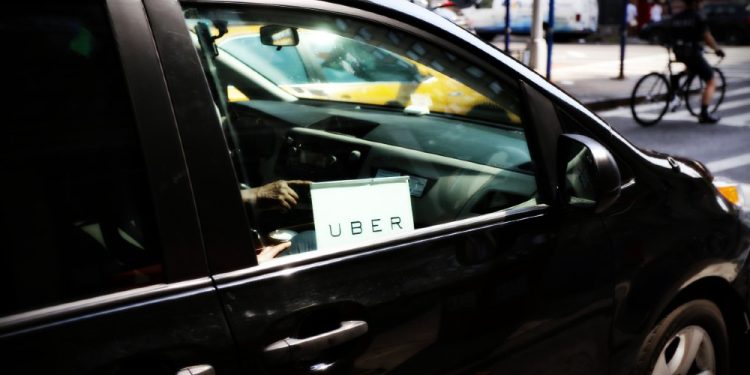(Natural News)—The Empire State has established lofty zero-emissions goals for the year 2030 that require large numbers of electric vehicles (EVs) to rove the state at that time rather than traditional gas-powered cars. The latest figures, however, show that there will not be nearly enough electric power available to charge them.
In New York City specifically, the goal is to force all Uber, Lyft, and other ridesharing companies to produce zero emissions by the year 2030. In “green” speak, this means that all ride-sharing vehicles in the Big Apple will need to be electric in just seven years.
Right now, only about 2,200 of the city’s 78,000 cars currently authorized by the city’s Taxi and Limousine Commission (TLC) as app-based rideshares – this means Uber and Lyft rather than traditional taxi services – are EVs. The rest are normal cars that, gasp, use gasoline instead of a charging station to refuel.
By the end of 2026, TLC expects the number of EVs in the app-based ridesharing fleet to reach 25 percent of the overall fleet, which leaves just four after that to convert the remaining 75 percent – a likely impossible feat.
Should there be anything close to that amount of app-based ridesharing vehicles on the streets of New York City at that time, there will almost certainly not be enough charging stations, let alone electricity to power them, available to keep things running smoothly.
“[T]he existing charging network in New York City is not adequate even in the most optimistic scenario,” researchers from two separate government agencies warned in an April 2022 study.
“[A]lthough charging is demanded in areas nearby high trip demand, fast charging ports are also demanded in areas near driver residences as a supplement for home charging in scenarios with limited overnight charging access.”
(Related: Be sure to check out our earlier report explaining why EVs are a scam.)
Only 187 EV “fast chargers” currently exist in NYC
If the electric-for-hire fleet in New York City reaches the 21,000 EV benchmark that the TLC hopes to achieve by the year 2027, then the city will need many more than the mere 1,000 direct-current “fast chargers” that currently exist throughout the city.
These “fast chargers,” we are told, can top up an EV’s battery in just 20 minutes, as opposed to an hour. Such “fast chargers” would make EVs more comparable to gas-powered cars, which, coupled with a meandering visit inside the gas station convenience store, could take around 20 minutes to fill up – if one dawdles, anyway.
At the current time, there are a measly 187 direct-current “fast chargers” in New York City. They are distributed among 38 charging stations citywide, most of them in Brooklyn, which has 68 of them at six locations, and in Queens, which has 65 of them at 16 locations.
Manhattan has just 27 fast-charging ports at 11 stations, while Staten Island has 15 fast-charging ports distributed across four stations. In the Bronx, there is just one fast-charging station, a Tesla Supercharger facility located at the Bay Plaza Mall, which has a dozen overall EV charging ports.
It is important to note that in order to successfully fast-charge one’s EV, the owner must have the right plug. Standard plugs still take a whole lot longer to recharge a vehicle, typically overnight, which is not necessarily viable for drivers who take passengers here and there all throughout the day for work.
Another thing to consider is the infrastructure layout in New York City. Many properties exist in multi-family locations where owners park on the street, meaning there is no garage charger available like there would be at a single-family home out in the suburbs.
The latest news about the zero emissions goals for 2030 can be found at GreenTyranny.news.
Sources for this article include:
Five Things New “Preppers” Forget When Getting Ready for Bad Times Ahead
The preparedness community is growing faster than it has in decades. Even during peak times such as Y2K, the economic downturn of 2008, and Covid, the vast majority of Americans made sure they had plenty of toilet paper but didn’t really stockpile anything else.
Things have changed. There’s a growing anxiety in this presidential election year that has prompted more Americans to get prepared for crazy events in the future. Some of it is being driven by fearmongers, but there are valid concerns with the economy, food supply, pharmaceuticals, the energy grid, and mass rioting that have pushed average Americans into “prepper” mode.
There are degrees of preparedness. One does not have to be a full-blown “doomsday prepper” living off-grid in a secure Montana bunker in order to be ahead of the curve. In many ways, preparedness isn’t about being able to perfectly handle every conceivable situation. It’s about being less dependent on government for as long as possible. Those who have proper “preps” will not be waiting for FEMA to distribute emergency supplies to the desperate masses.
Below are five things people new to preparedness (and sometimes even those with experience) often forget as they get ready. All five are common sense notions that do not rely on doomsday in order to be useful. It may be nice to own a tank during the apocalypse but there’s not much you can do with it until things get really crazy. The recommendations below can have places in the lives of average Americans whether doomsday comes or not.
Note: The information provided by this publication or any related communications is for informational purposes only and should not be considered as financial advice. We do not provide personalized investment, financial, or legal advice.
Secured Wealth
Whether in the bank or held in a retirement account, most Americans feel that their life’s savings is relatively secure. At least they did until the last couple of years when de-banking, geopolitical turmoil, and the threat of Central Bank Digital Currencies reared their ugly heads.
It behooves Americans to diversify their holdings. If there’s a triggering event or series of events that cripple the financial systems or devalue the U.S. Dollar, wealth can evaporate quickly. To hedge against potential turmoil, many Americans are looking in two directions: Crypto and physical precious metals.
There are huge advantages to cryptocurrencies, but there are also inherent risks because “virtual” money can become challenging to spend. Add in the push by central banks and governments to regulate or even replace cryptocurrencies with their own versions they control and the risks amplify. There’s nothing wrong with cryptocurrencies today but things can change rapidly.
As for physical precious metals, many Americans pay cash to keep plenty on hand in their safe. Rolling over or transferring retirement accounts into self-directed IRAs is also a popular option, but there are caveats. It can often take weeks or even months to get the gold and silver shipped if the owner chooses to close their account. This is why Genesis Gold Group stands out. Their relationship with the depositories allows for rapid closure and shipping, often in less than 10 days from the time the account holder makes their move. This can come in handy if things appear to be heading south.
Lots of Potable Water
One of the biggest shocks that hit new preppers is understanding how much potable water they need in order to survive. Experts claim one gallon of water per person per day is necessary. Even the most conservative estimates put it at over half-a-gallon. That means that for a family of four, they’ll need around 120 gallons of water to survive for a month if the taps turn off and the stores empty out.
Being near a fresh water source, whether it’s a river, lake, or well, is a best practice among experienced preppers. It’s necessary to have a water filter as well, even if the taps are still working. Many refuse to drink tap water even when there is no emergency. Berkey was our previous favorite but they’re under attack from regulators so the Alexapure systems are solid replacements.
For those in the city or away from fresh water sources, storage is the best option. This can be challenging because proper water storage containers take up a lot of room and are difficult to move if the need arises. For “bug in” situations, having a larger container that stores hundreds or even thousands of gallons is better than stacking 1-5 gallon containers. Unfortunately, they won’t be easily transportable and they can cost a lot to install.
Water is critical. If chaos erupts and water infrastructure is compromised, having a large backup supply can be lifesaving.
Pharmaceuticals and Medical Supplies
There are multiple threats specific to the medical supply chain. With Chinese and Indian imports accounting for over 90% of pharmaceutical ingredients in the United States, deteriorating relations could make it impossible to get the medicines and antibiotics many of us need.
Stocking up many prescription medications can be hard. Doctors generally do not like to prescribe large batches of drugs even if they are shelf-stable for extended periods of time. It is a best practice to ask your doctor if they can prescribe a larger amount. Today, some are sympathetic to concerns about pharmacies running out or becoming inaccessible. Tell them your concerns. It’s worth a shot. The worst they can do is say no.
If your doctor is unwilling to help you stock up on medicines, then Jase Medical is a good alternative. Through telehealth, they can prescribe daily meds or antibiotics that are shipped to your door. As proponents of medical freedom, they empathize with those who want to have enough medical supplies on hand in case things go wrong.
Energy Sources
The vast majority of Americans are locked into the grid. This has proven to be a massive liability when the grid goes down. Unfortunately, there are no inexpensive remedies.
Those living off-grid had to either spend a lot of money or effort (or both) to get their alternative energy sources like solar set up. For those who do not want to go so far, it’s still a best practice to have backup power sources. Diesel generators and portable solar panels are the two most popular, and while they’re not inexpensive they are not out of reach of most Americans who are concerned about being without power for extended periods of time.
Natural gas is another necessity for many, but that’s far more challenging to replace. Having alternatives for heating and cooking that can be powered if gas and electric grids go down is important. Have a backup for items that require power such as manual can openers. If you’re stuck eating canned foods for a while and all you have is an electric opener, you’ll have problems.
Don’t Forget the Protein
When most think about “prepping,” they think about their food supply. More Americans are turning to gardening and homesteading as ways to produce their own food. Others are working with local farmers and ranchers to purchase directly from the sources. This is a good idea whether doomsday comes or not, but it’s particularly important if the food supply chain is broken.
Most grocery stores have about one to two weeks worth of food, as do most American households. Grocers rely heavily on truckers to receive their ongoing shipments. In a crisis, the current process can fail. It behooves Americans for multiple reasons to localize their food purchases as much as possible.
Long-term storage is another popular option. Canned foods, MREs, and freeze dried meals are selling out quickly even as prices rise. But one component that is conspicuously absent in shelf-stable food is high-quality protein. Most survival food companies offer low quality “protein buckets” or cans of meat, but they are often barely edible.
Prepper All-Naturals offers premium cuts of steak that have been cooked sous vide and freeze dried to give them a 25-year shelf life. They offer Ribeye, NY Strip, and Tenderloin among others.
Having buckets of beans and rice is a good start, but keeping a solid supply of high-quality protein isn’t just healthier. It can help a family maintain normalcy through crises.
Prepare Without Fear
With all the challenges we face as Americans today, it can be emotionally draining. Citizens are scared and there’s nothing irrational about their concerns. Being prepared and making lifestyle changes to secure necessities can go a long way toward overcoming the fears that plague us. We should hope and pray for the best but prepare for the worst. And if the worst does come, then knowing we did what we could to be ready for it will help us face those challenges with confidence.






Well, yes . . . that is the whole point . . .THAT is The Plan!
Why the Uber/Lyft concept to replace taxis? One can still anonymously travel by taxi to avoid realtime tracking, not so with the others and why so many of those Uber types are with the CDAO!? (And wastes precious rare earth metals!)
NOT a coincidence! (E.g., Brett Goldstein)